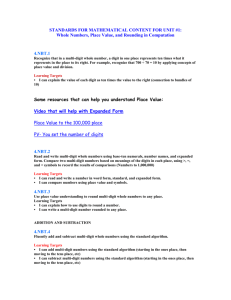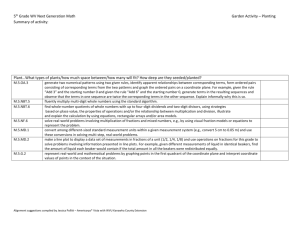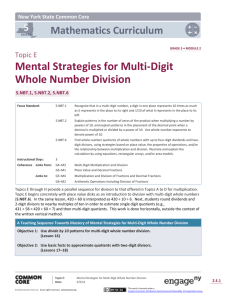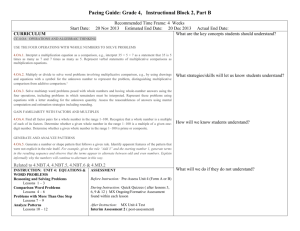File - Agora Cyber Charter School K
advertisement
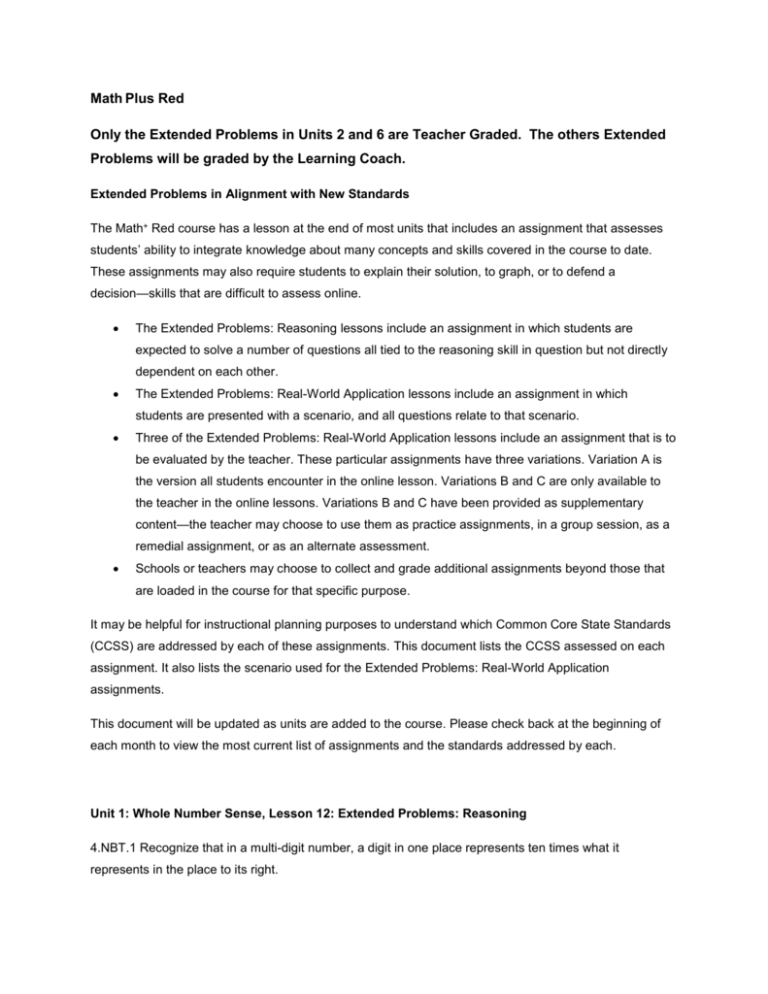
Math Plus Red Only the Extended Problems in Units 2 and 6 are Teacher Graded. The others Extended Problems will be graded by the Learning Coach. Extended Problems in Alignment with New Standards The Math+ Red course has a lesson at the end of most units that includes an assignment that assesses students’ ability to integrate knowledge about many concepts and skills covered in the course to date. These assignments may also require students to explain their solution, to graph, or to defend a decision—skills that are difficult to assess online. The Extended Problems: Reasoning lessons include an assignment in which students are expected to solve a number of questions all tied to the reasoning skill in question but not directly dependent on each other. The Extended Problems: Real-World Application lessons include an assignment in which students are presented with a scenario, and all questions relate to that scenario. Three of the Extended Problems: Real-World Application lessons include an assignment that is to be evaluated by the teacher. These particular assignments have three variations. Variation A is the version all students encounter in the online lesson. Variations B and C are only available to the teacher in the online lessons. Variations B and C have been provided as supplementary content—the teacher may choose to use them as practice assignments, in a group session, as a remedial assignment, or as an alternate assessment. Schools or teachers may choose to collect and grade additional assignments beyond those that are loaded in the course for that specific purpose. It may be helpful for instructional planning purposes to understand which Common Core State Standards (CCSS) are addressed by each of these assignments. This document lists the CCSS assessed on each assignment. It also lists the scenario used for the Extended Problems: Real-World Application assignments. This document will be updated as units are added to the course. Please check back at the beginning of each month to view the most current list of assignments and the standards addressed by each. Unit 1: Whole Number Sense, Lesson 12: Extended Problems: Reasoning 4.NBT.1 Recognize that in a multi-digit number, a digit in one place represents ten times what it represents in the place to its right. 4.NBT.2. Read and write multi-digit whole numbers using base-ten numerals, number names, and expanded form. Compare two multi-digit numbers based on meanings of the digits in each place, using >, =, and < symbols to record the results of comparisons. 4.NBT.3. Use place value understanding to round multi-digit whole numbers to any place. Unit 2: Whole Number Operations, Lesson 24: Extended Problems: Real-World Application (Teacher Graded Assignment) Variation A Scenario: The Chung family is visiting Wacky World Water Park on their vacation. Variation B Scenario: The Lopez family owns Sunny Acres Vegetable and Petting Farm. Variation C Scenario: Mateo and Aria’s family owns Rossetti’s Flower Shop and Greenhouse. 4.OA.1. Interpret a multiplication equation as a comparison. Represent verbal statements of multiplicative comparisons as multiplication equations. (Variations A and C only) 4.OA.3. Solve multistep word problems posed with whole numbers and having whole-number answers using the four operations, including problems in which remainders must be interpreted. Represent these problems using equations with a letter standing for the unknown quantity. Assess the reasonableness of answers using mental computation and estimation strategies including rounding. 4.OA.4. Find all factor pairs for a whole number in the range 1-100. Recognize that a whole number is a multiple of a given one-digit number. Determine whether a given whole number in the range 1-1—is prime or composite. 4.NBT.5. Multiply a whole number of up to four digits by a one-digit whole number, and multiply two twodigit numbers, using strategies based on place value and the properties of operations. 4.NBT.6. Find whole-number quotients and remainders with up to four-digit dividends and one-digit divisors, using strategies based on place value, the properties of operations, and/or the relationship between multiplication and division. Unit 3: Applications and Operations, Lesson 11: Extended Problems: Reasoning 4.OA.3. Solve multistep word problems posed with whole numbers and having whole-number answers using the four operations, including problems in which remainders must be interpreted. Represent these problems using equations with a letter standing for the unknown quantity. Assess the reasonableness of answers using mental computation and estimation strategies including rounding. (Only the part of the standard shown in bold was assessed.) Unit 4: Lines, Angles, and Rotations, Lesson 10: Extended Problems: Real-World Application Scenario: Jonathon and Addison are doing work for neighbors to make some extra money during the summer. 2.MD.1. Measure the length of an object by selecting and using appropriate tools such as rulers, yardsticks, meter sticks, and measuring tapes. 3.MD.7b Multiply side lengths to find areas of rectangles with whole-number side lengths in the context of solving real world and mathematical problems, and represent whole-number products as rectangular areas in mathematical reasoning. 3.MD.8. Solve real world and mathematical problems involving perimeters of polygons, including find the perimeter give the side lengths, finding an unknown side length, and exhibiting rectangles with the same perimeter and different areas or with the same area and different perimeters. 4.MD.6. Measure angles in whole number degrees using a protractor. Sketch angles of specified measure. 4.MD.7. Recognize angle measure as additive. When an angle is decomposed into non-overlapping parts, the angle measure of the whole is the sum of the angle measures of the parts. Solve addition and subtraction problems to find unknown angles on a diagram in real world and mathematical problems by using an equation with a symbol for the unknown angle measure. 4.OA.3. Solve multistep word problems posed with whole numbers and having whole-number answers using the four operations including problems in which remainders must be interpreted. Represent these problems using equations with a letter standing for the unknown quantity. Unit 5: Fraction Sense, Lesson 19: Extended Problems: Reasoning 3.G.2. Partition shapes into parts with equal areas. Express the area of each part as a unit fraction of the whole. 3.OA.9. Identify arithmetic patterns in the addition table or multiplication table, and explain them using properties of operations. 4.NF.1 Explain why a fraction a/b is equivalent to a fraction (n × a)/(n × b) by using visual fraction models, with attention to how the number and size of the parts differ even though the two fractions themselves are the same size. Use this principle to recognize and generate equivalent fractions. 4.NF.2 Compare two fractions with different numerators and different denominators, e.g., by creating common denominators or numerators, or by comparing to a benchmark fraction such as 1/2. Recognize that comparisons are valid only when the two fractions refer to the same whole. Record the results of comparisons with symbols >, =, or <, and justify the conclusions, e.g., by using a visual fraction model. Unit 6: Function Basics, Lesson 10: Extended Problems: Real-World Application (Teacher Graded Assignment) Variation A Scenario: Zack and Allie are helping their uncle clean out his garage. Variation B Scenario: The children at a summer camp take turns helping out around the camp. Nina and Stevie work together on some of the chores. Variation C Scenario: Kai and Misha have more time to work on their hobbies in the summer. 2.OA.6. Add up to four two-digit numbers using strategies based on place value and properties of operations. (Variation A only) 3.MD.8. Solve real world and mathematical problems involving perimeters of polygons, including finding the perimeter given the side lengths, finding an unknown side length, and exhibiting rectangles with the same perimeter and different areas or with the same area and different perimeters. (Only the part of the standard shown in bold was assessed.) (Variation B only) 3.NBT.1 Use place value understanding to round whole numbers to the nearest 10 or 100. (Variation A and B only) 3.NF.1 Understand a fraction 1b as the quantity formed by 1 part when a whole is partitioned into b equal parts; understand a fraction a/b as the quantity formed by a parts of size 1/b. (Variation A only) 3.NF.3.a. Understand two fractions as equivalent (equal) if they are the same size, or the same point on a number line. (Variation A only) 3.OA.3. Use multiplication and division within 100 to solve word problems in situations involving equal groups, arrays, and measurement quantities by using drawings and equations with a symbol for the unknown number to represent the problem. 3.OA.9. Identify arithmetic patterns (including patterns in the addition table or multiplication table), and explain them using properties of operations. (Variation C only) 4.MD.1. Know relative sizes of measurement units within one system of units including km, m, cm; kg, g; lb, oz.; l, ml; hr, min, sec. Within a single system of measurement, express measurements in a larger unit in terms of a smaller unit. 4.MD.2. Use the four operations to solve word problems involving distances, intervals of time, liquid volumes, masses of objects, and money, including problems involving simple fractions or decimals, and problems that require expressing measurements given in a larger unit in terms of a smaller unit. Represent measurement quantities using diagrams such as number line diagrams that feature a measurement scale. (Only the part of the standard shown in bold was assessed.) 4.OA.2. Multiply or divide to solve word problems involving multiplicative comparison, e.g., by using drawings and equations with a symbol for the unknown number to represent the problem, distinguishing multiplicative comparison from additive comparison. (Only the part of the standard shown in bold was assessed.) (Variation C only) 4.OA.3. Solve multistep word problems posed with whole numbers and having whole-number answers using the four operations, including problems in which remainders must be interpreted. Represent these problems using equations with a letter standing for the unknown quantity. Assess the reasonableness of answers using metal computation and estimation strategies including rounding. (Only the part of the standard shown in bold was assessed.)
